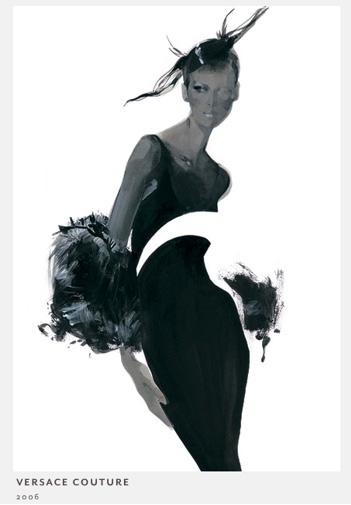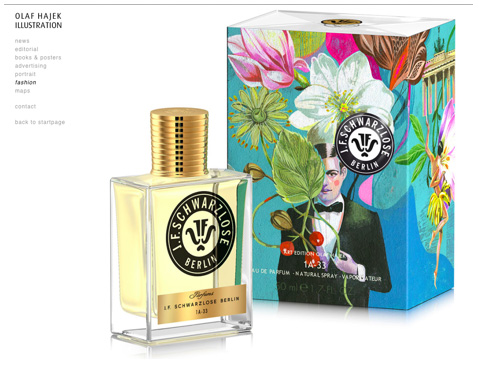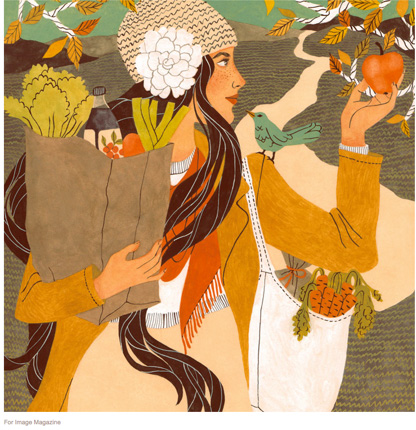Fashion Illustration: The Evolution of Style
By Jackie Zhu
Fashion illustration has always engaged audiences, originally serving a promotional role for fashion magazines, clothing designers, and department stores which sold their wares. This style of illustration is usually exaggerated to express and elevate the elegance and glamour of luxury life, but not too far from real-life situations. However, with the introduction of fashion photography in the early decades of the twentieth century, the fashion illustration market faced a downturn. Being just beautiful was not marketable anymore. The new generation of fashion illustrators has grown up with very different art influences compared to the previous, and the expanded market of globalization has drastically changed the aesthetic of fashion illustration in today’s world.
David Dowton is an active fashion illustrator who depicts his female figure in a traditional style. This image is either for the Versace Couture 2006 collection portrays a simple black dress; the woman in the picture is elongated to showcase its fit and form. The use of color is minimal, and the sweep of the fur piece and gesture suggests the edgy energy in an elegant tone that suits the taste of high fashion.
However Olaf Hajek, a famous German fashion illustrator approached fashion in a different way. In his package illustration for Schwarzlose perfume, the male figure here appears stiff and still. His face is partially obscured but eye-catching because of his strongly delineated hairstyle and eyebrow. The fashion element here is represented through the tuxedo he wears and the exotic plants wrapped around him. Compared with David Downton’s figure, Hajek’s fashion illustration shifts its focus from the beauty of the figure to the aesthetic qualities of the whole composition.
If the Dowton and Hajek’s illustrations still have the traditional sense of beauty in their art, Riikka Sormunen and Yuko Shimizu represent the avant garde in the fashion editorial world. In Somunen’s illustration for Image Magazine, we see a woman picking an apple in the fall season. Here, the figure is neither elongated, as in the conventional fashion illustration, nor in an elegant pose. Rather, the lady is portrayed in a highly stylized pose as seen in ancient Egyptian art, in which the figures are usually composed with faces in profile and a front view bodies. The woman’s hand and flowy hair and surrounding tree branch are stylized, offering interesting and unique perspective and sense of overall pattern. This design-based approach and quirky aesthetic reflects the idea of unique beauty, which is culturally significant today.
Shimizu’s NYLON advertising illustration introduces beauty from a different cultural background. Of Japanese heritage, she introduces a stylish figure inspired by an Edo period (1603-1867) Japanese woman, reflected in her hairstyle, slender eyes, East Asian features. Seen from above, she is relaxing on a rug in a pose seductively suggestive of a self-assured woman enjoying a sunny day at the beach. Tattoos created by various cosmetic products cover her body only. In this illustration, the figure is far from conventional idea of what a beautiful woman should be from both a western and eastern viewpoint. The figure’s head is relatively larger than in more conventional fashion illustrations, in which figures are portrayed as at least nine heads tall. Her lowered eyelids and slightly opened mouth appear seductive, eschewing the more traditionally portrayed almond shaped sparkling eyes. In the Edo period, with the rise of the middle class, Ukiyo-e woodblock prints became a prominent form of expression in Japanese art. Women were depicted often in these works, but Shimizu’s appropriation of the form adds a cultural twist and pushes the envelope to blend the old with the new.
Because of the internet and globalization, the fashion illustration market no longer holds to a single aesthetic direction. Bold and individualistic imagery has moved beyond the traditional sense of elegance and glamour that has traditionally been associated with fashion. Fashion illustrators in this age express their aesthetic taste, their cultural interests, and their personal identities to meet the needs of diverse audiences and markets.
Image reference:
David, Downton. Versace Couture. 2006, Web. Oct 12 2014. <https://www.daviddownton.com/couture/>
Olaf, Hajek. Package Schwarzlose Perfume. Schwarzlose Perfume, Berlin, Web. Oct 12 2014. <https://olafhajek.de/index_illu.php?menuid=2&serieid=242>
Riikka, Sormunen. Image Magazine, Web. Oct 12 2014. <https://www.riikkas.com/illustration.html>
Yoku, Shimizu. Tattoo You. June and July 2007, NYLON magazine, New York, Web. Oct 12 2014. <https://yukoart.com/work/nylon-tattoo-you/#1>
About Jackie Zhu
Jackie Zhu studied fashion design at the Fashion Institute of Technology in New York, and has worked as a freelance illustrator and gift designer. She is currently a graduate student in the Illustration Practice program at MICA (Maryland Institute College of Art) in Baltimore.










